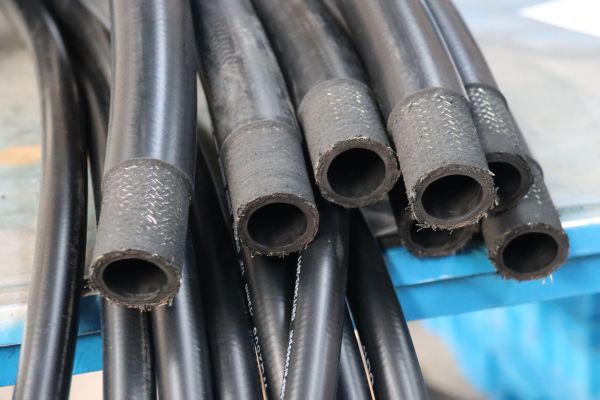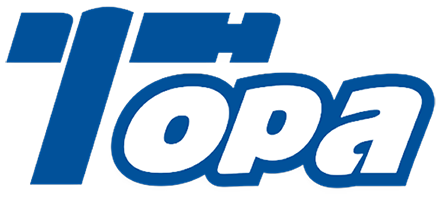Choosing the wrong hydraulic hose is a serious problem. With dozens of standards like SAE 100R19 and various EN specs, the confusion can lead to leaks, costly downtime, and even dangerous equipment failures.
It’s actually much simpler than you think. Pressure hoses fall into three main types: wire-reinforced rubber, textile-reinforced thermoplastic, or stainless-braided Teflon. Understanding these three categories makes it easy to select the right hose by matching it to your specific application’s needs.
What’s Inside a Hydraulic Hose?
If you just look at the outside, most hoses look the same. This makes it impossible to judge a hose’s strength or suitability for your job, leading to poor purchasing decisions.
A hydraulic hose has three layers: an inner tube to carry the fluid, a reinforcement layer to provide strength against pressure, and an outer cover to protect it from the environment. The material and construction of these layers determine the hose’s performance.

Think of it like building a bridge. The inner tube is the road, the reinforcement is the steel support structure, and the outer cover is the weather-resistant paint. Each component is critical. The inner tube must be compatible with your hydraulic fluid, the reinforcement must be strong enough for your system’s pressure, and the cover must withstand the abrasion, ozone, and chemicals in its operating environment.
The Inner Tube: Containing the Flow
This is the innermost layer that is in direct contact with the hydraulic fluid. It must be smooth to ensure efficient flow and, most importantly, chemically compatible with the fluid (e.g., petroleum-based oils, water-glycol). Most hydraulic hoses use a synthetic rubber like Nitrile (NBR) for the tube because of its excellent oil resistance.
The Reinforcement Layer: Providing the Strength
This is the powerhouse of the hose. It’s what prevents the tube from bursting under thousands of pounds of pressure. Reinforcement can be made of several materials:
- Textile Braid: For low-pressure applications, usually under 1,000 psi.
- Steel Wire Braid: The most common type, for medium to high pressures.
- Steel Wire Spiral: For very high and ultra-high pressure applications.
The number of layers of braid or spiral determines the hose’s pressure rating.
The Outer Cover: The First Line of Defense
The cover protects the reinforcement layers from the outside world. It is designed to resist abrasion, weather, ozone, chemicals, and oil. Most covers are made from a durable synthetic rubber. For extremely abrasive environments, some manufacturers offer special covers, like those coated with UHMW (Ultra-High-Molecular-Weight) polyethylene for superior protection.
Which Rubber Hose Do You Need for High Pressure?
Your machine operates at high pressure, and you need a tough, reliable hose. With options from one to six layers of reinforcement, choosing the wrong one means either overspending or risking a dangerous failure.
For high-pressure systems, you need a rubber hose with steel wire reinforcement. The number of wire layers dictates the pressure rating. Two-wire braid is common for medium pressures, while four and six-wire spiral hoses are used for high to ultra-high pressure construction equipment.

Rubber hydraulic hose is the industry standard for a reason: it’s durable, flexible, and cost-effective. The nitrile rubber inner tube is compatible with almost all standard hydraulic oils. The key is to match the number of reinforcement layers to your system’s working pressure. More layers mean a higher pressure rating but also a stiffer hose with a larger bend radius. It’s a trade-off between strength and flexibility.
Common Steel Reinforcement Levels
The strength of the hose comes from high-tensile steel wire, applied in either braided or spiral-wrapped layers.
- 1-Wire Braid: Used for lower-pressure hydraulic systems. Less common than 2-wire.
- 2-Wire Braid: The most common type of hydraulic hose. Found on a huge range of equipment with medium-pressure requirements.
- 4-Wire Spiral: For high-pressure equipment that experiences shock loads and pressure impulses, often rated for 4,000 to 6,000 psi.
- 6-Wire Spiral: Reserved for extreme, ultra-high pressure applications on large-diameter hoses, capable of handling up to 7,000 psi.
Special Application Rubber Hoses
Beyond standard pressure ratings, rubber hoses can be designed for specific environments. We can supply hoses built to withstand extreme temperatures, from as low as -70°F (-57°C) for arctic conditions to as high as 300°F (150°C) for use near engines or other hot components.
When is a Thermoplastic Hose a Better Choice?
You’re working on a forklift or an aerial lift near power lines. A standard steel-reinforced rubber hose could conduct electricity, creating a massive safety hazard for the operator.
Thermoplastic hose is the better choice when abrasion resistance or electrical non-conductivity is required. Its tough polyurethane cover stands up to wear, and its synthetic fiber reinforcement makes it a safe option for use around electrical hazards like power lines.

Construction and Performance
A typical thermoplastic hose is constructed differently from a rubber hose.
- Inner Tube: Often made of nylon.
- Reinforcement: Instead of steel wire, it uses layers of synthetic fiber like polyester or aramid.
- Outer Cover: Usually a very tough, abrasion-resistant polyurethane.
This construction gives it pressure ratings comparable to 1-wire and 2-wire rubber hoses, making it a strong but lightweight alternative.
Key Applications
You’ll find thermoplastic hoses used in a variety of places where their unique properties shine:
- Material Handling: The durable cover is great for the constant rubbing on forklift masts.
- Hydraulic Lifts: Ideal for man lifts and other aerial equipment.
- General Hydraulics: A good lightweight option for medium-pressure systems.
- Electrical Equipment: Its non-conductive properties are essential for any equipment used near power sources.
Why Use a Teflon (PTFE) Hose?
You’re dealing with extreme heat or aggressive chemicals. A standard rubber hose would quickly degrade, causing a dangerous failure and costly cleanup.
Use Teflon (PTFE) hoses for applications requiring high-temperature performance (up to 450°F / 232°C) or compatibility with corrosive chemicals. The stainless steel braid reinforcement provides strength and excellent corrosion resistance, making it the superior choice for these demanding environments.

Teflon hoses are highly specialized problem-solvers. The PTFE inner tube is nearly inert, meaning it won’t react with the vast majority of chemicals. The stainless steel braid not only provides the pressure rating but also protects the tube and resists external corrosion without needing a rubber cover. When you have an application that is too hot or too chemically aggressive for rubber, Teflon is the answer. However, you must be aware of its unique handling and sizing characteristics.
Important Sizing Considerations
This is the most critical detail for procurement managers. Unlike rubber hoses, the dash size on a Teflon hose does not directly equal its ID in sixteenths of an inch. The ID is typically 1/16″ smaller.
- A -04 Teflon hose has a 3/16″ ID (not 1/4″).
- A -06 Teflon hose has a 5/16″ ID (not 3/8″).
Always verify the actual inner diameter from the spec sheet to ensure you get the flow rate you need.
Avoiding Kinks and Damage
The PTFE inner tube is a hard plastic. If you bend the hose too sharply, the tube can develop a permanent kink. This creates a weak spot and restricts flow, effectively ruining the hose. You must always respect the manufacturer’s specified minimum bend radius, especially when installing Teflon hoses in tight spaces.
What About Return and Suction Hoses?
Not every hose in a system is under high pressure. Fluid has to get back to the tank, and a standard pressure hose is expensive overkill and may not even work correctly.
Return and suction hoses are designed specifically for low-pressure applications. They use a textile braid reinforcement and often include a spiral steel wire helix. This helix prevents the hose from collapsing under the vacuum created during suction, a job a normal pressure hose cannot do.

Using the right hose for the right job saves money and ensures proper system function. Return lines simply carry low-pressure fluid back to the reservoir. Suction lines pull fluid from the reservoir into the pump. A pressure hose would work for a return line, but it is much heavier and more expensive than necessary. For a suction line, a pressure hose is unsuitable because it lacks the internal reinforcement to resist being crushed by vacuum forces.
The Unique Construction
The key feature of a suction-rated hose is the **helix**. This is a spiral wire embedded within the hose’s construction. While the textile braid handles a small amount of positive pressure, the helix provides the rigid structure needed to keep the hose from flattening when the pump is drawing fluid through it. This ensures a steady, uninterrupted flow of oil to the pump, preventing cavitation and damage.
Are There Special Hoses for Trucks?
You are sourcing parts for a fleet of highway trucks. You see a hose with a fabric cover instead of rubber, and the sizing seems strange. This is a common point of confusion.
Yes, there is a special class of hose for trucks, defined by the SAE 100R5 standard. It has a single steel wire braid reinforcement but is covered by a textile braid instead of rubber. It is widely used in truck air brake, fuel, and hydraulic systems.

The 100R5 standard is a long-standing staple in the trucking industry. The textile cover is durable, and these hoses are often used with field-attachable (reusable) fittings, making them easy to repair on the road. The most important thing for a buyer to know is that, like Teflon hose, its sizing system is unique and does not follow the standard dash size-to-ID convention. Misunderstanding this can easily lead to ordering the wrong part.
The 100R5 Sizing Quirk
Be very careful when ordering 100R5 hose. Its actual inner diameter is significantly smaller than the standard dash size would suggest. The difference can be anywhere from 1/16″ to over 1/8″ depending on the size. For example, a -12 (3/4″) 100R5 hose may actually have an ID closer to 5/8″. There is no substitute for checking the manufacturer’s catalog to confirm the true ID and ensure it meets your system’s flow requirements. If you are ever in doubt, our experts are here to help you verify the correct size.
How Do You Read Hydraulic Hose Specs?
You see a part number like H28006, but what does it mean? Not understanding hose specifications can lead you to order a part that simply won’t fit, wasting time and money.
The most important specs are the inner diameter (ID) and pressure rating. The hose ID is noted by a dash size, which represents sixteenths of an inch. A hose’s safety factor is typically 4:1, meaning a 3,000 psi hose won’t burst until at least 12,000 psi.

Understanding Dash Sizes
The part number on a hose usually tells you its specification and size. For example, a hose labeled “H28006” refers to the H280 spec in a -06 size. The dash size is a simple fraction.
- -04 = 4/16″ = 1/4″ Inner Diameter
- -08 = 8/16″ = 1/2″ Inner Diameter
- -12 = 12/16″ = 3/4″ Inner Diameter
- -16 = 16/16″ = 1″ Inner Diameter
This system is standard for most rubber and thermoplastic hoses, but as we’ll see later, there are important exceptions.
Why the 4:1 Safety Factor Matters
Safety is critical in high-pressure hydraulics. The 4:1 safety factor gives you a huge margin of protection against unexpected pressure spikes and hose wear. A hose rated for 3,000 psi “working pressure” is designed for continuous use at that level. The much higher “burst pressure” (12,000+ psi) ensures that a sudden surge won’t cause a catastrophic failure. Some specialty hoses, like those for hydraulic jacks in static, low-cycle environments, may use a 2:1 factor, but 4:1 is the industry standard for dynamic systems. If you have any doubts, ask us.
Conclusion
Choosing the right hydraulic hose is simple. It all comes down to understanding the three main types and matching them to your system’s pressure, temperature, and environment. Our team is always ready to help you find the perfect hose for your application.
With strict quality control, fast delivery, and competitive pricing, we make sure your equipment runs safely and without delay. Whether you need standard products or custom solutions, our team is ready to support your business. Contact us today to place your order and experience the Topa advantage.
FAQ
What are the three main types of hydraulic hoses?
The main types are rubber hoses with steel reinforcement, thermoplastic hoses with textile reinforcement, and stainless-braided Teflon (PTFE) hoses.
How is a hydraulic hose constructed?
Every hose has three layers: an inner tube for fluid, a reinforcement layer for pressure strength, and an outer cover for environmental protection.
Which hose should I use for high-pressure applications?
For high-pressure systems, use steel wire-braided or spiral rubber hoses. More wire layers mean higher pressure ratings.
When should I choose a thermoplastic hose?
Thermoplastic hoses are best when you need lightweight, abrasion-resistant, or non-conductive hoses, such as for forklifts or aerial lifts near power lines.
Why use a Teflon (PTFE) hose?
Teflon hoses handle extreme heat (up to 450°F / 232°C) and aggressive chemicals. They are reinforced with stainless steel braid for durability.
What does the 4:1 safety factor mean in hose ratings?
It means a hose rated for 3,000 psi working pressure won’t burst until at least 12,000 psi, providing a safety margin for pressure spikes.







